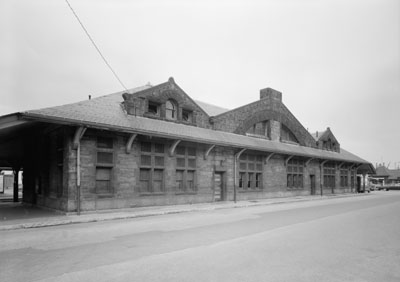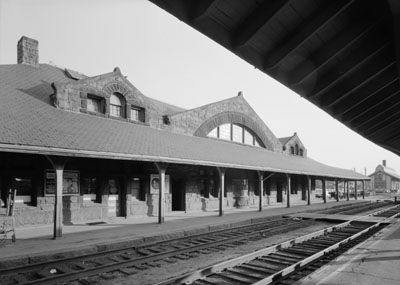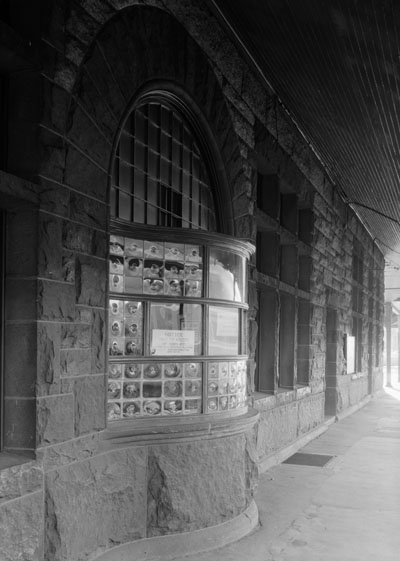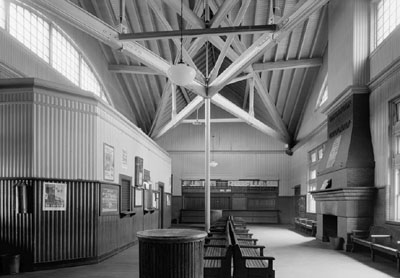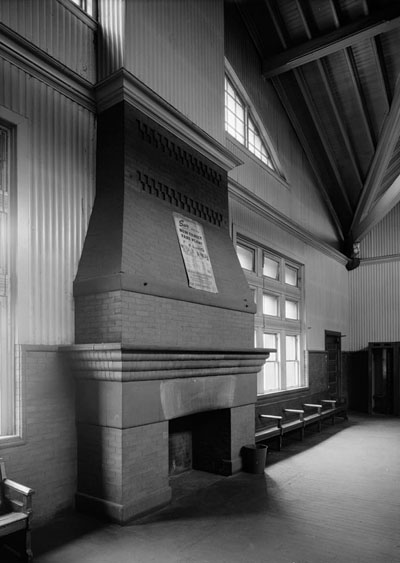FIRST BAPTIST CHURCH AND CARRIAGE SHED
Location: Framingham, Middlesex County, Massachusetts.
Significance: Built in 1826, the First Baptist Church continues to serve its congregation, and so, ranks as Framingham's oldest extant, operating church. The First Baptist Church is the only religious structure associated with the Boston architect, Solomon Willard.
Description: A wood building, the First Baptist Church sits on a granite foundation under a pitch roof. The east end foundation is hammered granite; the west rests on squared granite rubble. The front facade is made of matched boarding, while the north, south, and west sides are clapboard. Wrapping around the structure is a frieze and modillioned cornice. The church is two stories tall.
The front facade, approached by two granite steps leading up to a portico, is symmetrical. The portico is in the Ionic order and has paired columns at the corners. Matching the paired columns are four pairs of Ionic pilasters against the facade, two pairs answering the portico columns and the other pairs at each corner-end of the main block. The pilasters support an entablature and pediment. A semi-elliptical fanlight pierces the portico pediment. The east (front) facade is three bays. The first floor is a triple entrance; the center entry is emphasized by an elliptical arch stretching over a fanlight and sidelights. The two smaller doors have semi-circular arches with fanlights inside. All three doors are paneled. Above the central entrance is a serliana, or Palladian window, framed by pilasters. The window pilasters support a frieze. Two windows with semi-circular arched heads flank the serliana, mimicking the scale of the first floor fenestration.
The north and south sides are each six bays deep. The first and second stories are delineated by six windows on each level, that are primarily six-over-six sash. Some twelve-over-twelve sash exists in the gallery, or second story, level. Three windows (eight-over-eight light) illuminate the basement; these are on each side and located near the west end of the building. The south side also has an entry porch for access into the basement.
The west (rear) facade has two windows, at basement, ground, and gallery levels. The gable resembles a pediment, shaped by a raking modillioned cornice. A semi-elliptical fanlight is centered in the pediment, corresponding to the fanlight in the front facade. In 1856, the west end foundation was enclosed; a wing was added in 1886. This addition has a central entrance, covered by a bracketed hood. Two windows of two-over-two lights flank this entry. Above these openings are three more windows, also two-over-two sash.
A four stage tower rises up from the church; this tower tapers into an octagon spire. The base, or first stage, is square and presents a serliana on its east face. The serliana is trimmed with a cornice much like that on the main block. The second stage is also square in plan. This level acts as a belfry. Each side has a single arched opening complete with architrave, keystone, and fixed blinds. At the corners are Doric pilasters rising into an undecorated entablature. The third stage assumes an octagon shape; this level is a lantern. Doric pilasters frame each side; within the pilasters is an arched opening with a fixed blind. The fourth level replicates the third, only it is on a smaller scale. The 19'7" steeple rises above the fourth stage. A Banneret weathervane caps the spire. An arrow, scrolls, and the sun comprise the weathervane tail.
In plan, the First Baptist Church reflects traditional ecclesiastical planning, rather the eighteenth-century meeting house arrangement. The triple entrance in the east gable end is indicative of this kind of plan. Inside, the pews are arranged in a semi-circle around the pulpit. In the pulpit area is the baptismal vessel. In 1856-57, the box pews were removed and the sanctuary floor raised.
In addition to exterior changes in the west end, a slate roof was installed in 1910. Moreover, the tower railings decayed and blew away. The carriage sheds, that rivaled those of the Unitarian Meeting House in scale, were demolished.
History: In 1762, the Baptist Society organized themselves and gathered in a meeting house on Park's Corner. Later, the Society decided to replace their small church with a larger edifice in 1825. The congregation chose a site prominently located on the Boston-Worcester Turnpike (Route 9). The cornerstone was laid on November 17, 1825, with much fanfare. The ceremony included masonic rites. The Baptist Society pastor, Reverend Charles Train, oversaw the Society's move into that new building, named the First Baptist Church, in 1826. The dedication ceremony took place on January 1, 1827.
The First Baptist Church faces the Boston-Worcester Turnpike. It watched as the turnpike brought commercial development to Framingham Centre, growing until 1843. At that time, the Turnpike Corporation dissolved. The railroads by-passed Framingham Centre by 1853, leaving it as an enclave of federal period structures.
Solomon Willard, an architect from Boston, designed the church. Willard's architecture is associated with craftsman/architect Asher Benjamin, also of Boston. Willard either studied with Benjamin directly or learned through his architectural handbooks. Benjamin's influence surfaces in the Baptist church's architectural details common in federal period (1776-1830) designs. The First Baptist Church represents the federal period's neo-classical bent, especially in its facade. Willard's woodworking skills made his reputation; he is known as a cabinet maker and carpenter as well as an early American architect. To his credit, Willard designed the Bunker Hill Monument. Master builder, Colonel Harrington, raised the structure per Willard's plan.
Sources: "Historic Buildings of Massachusetts", edited by John C. Poppeliers. Scribner Historic Building Series. New York: Charles Scribner's Sons, 1976. Photographic catalogue of historic buildings, built primarily during the colonial and federal periods.
Inventory Form, Massachusetts Historical Commission, October 1979; updated February, 1983, and December 1983.
Pfeiffer, Brian, "National Register Nomination Form: First Baptist Church", National Register for Historic Places, National Park Service, 1979.
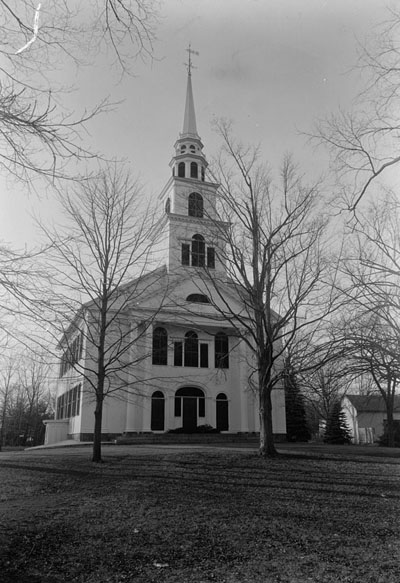
1. Historic American Buildings Survey Frank O. Branzetti, Photographer Dec. 19, 1940 (a) EXT.- FRONT ELEVATION, LOOKING WEST
HABS MASS,9-FRAM,5-1
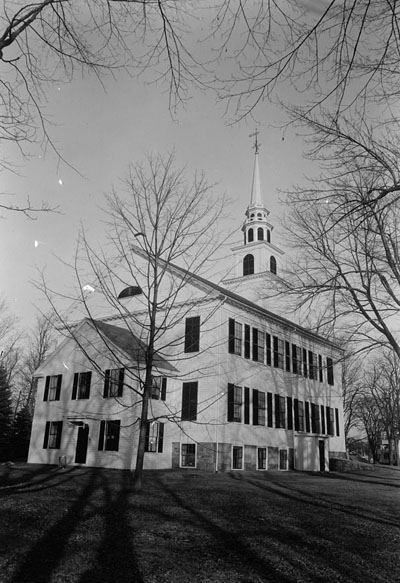
2. Historic American Buildings Survey Frank O. Branzetti, Photographer Dec. 19, 1940 (b) EXT.- REAR & SIDE ELEVATIONS, LOOKING NORTHEAST
HABS MASS,9-FRAM,5-2

3. Historic American Buildings Survey Frank O. Branzetti, Photographer Dec. 19, 1940 (c) EXT.- CARRIAGE SHED, LOOKING NORTHWEST
HABS MASS,9-FRAM,5-3
Many thanks to the Library of Congress.
